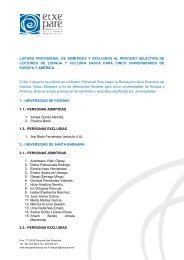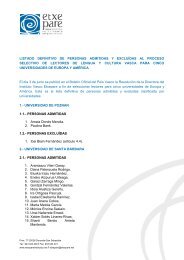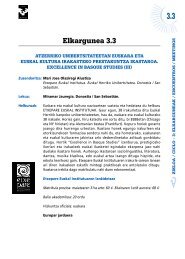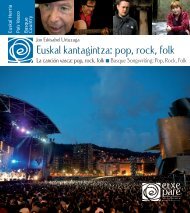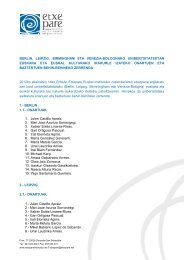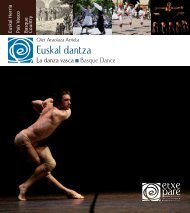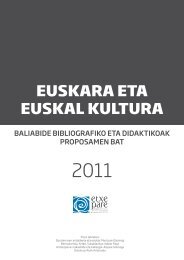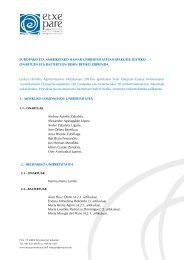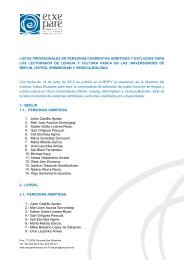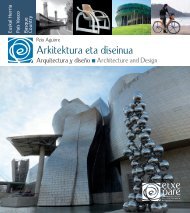XX. mendeko euskal literatura - Etxepare, Euskal Institutua
XX. mendeko euskal literatura - Etxepare, Euskal Institutua
XX. mendeko euskal literatura - Etxepare, Euskal Institutua
Create successful ePaper yourself
Turn your PDF publications into a flip-book with our unique Google optimized e-Paper software.
cada de 1970, la Guerra Civil y sus dolorosas consecuencias<br />
están muy presentes en las obras de Koldo<br />
Izagirre (1953). Prueba de ello es su novela realista<br />
Euzkadi merezi zuten (1984). En Metxa esaten dioten<br />
agirretar baten ibili herrenak (1997), a través de<br />
catorce narraciones llenas de humor e ironía, el autor<br />
narra las alegrías y tristezas de un veterano de la<br />
guerra, el obstinado Nikola de Agirre Metxa. Metxa<br />
protagonizó la siguiente novela de Izagirre, Agirre<br />
zaharraren kartzelaldi berriak (1999), en la que se<br />
da cuenta de la voluntaria condena del viejo gudari.<br />
La Guerra Civil y sus consecuencias se hallan presentes<br />
también en el libro de narraciones Sua nahi, Mr.<br />
Churchill? (2005).<br />
Ramón Saizarbitoria ha declarado que para él escribir<br />
es una lucha contra del olvido; escribe porque, al<br />
igual que su admirado Samuel Beckett, cuenta con<br />
una memoria precaria (Olaziregi 2009b). Por ello la<br />
memoria está muy presente en su obra. Con la frase<br />
“la memoria es un plato roto”, frase que el autor atribuye<br />
al escritor Claude Simon, da comienzo la novela<br />
Hamaika pauso. Basada en la agonía y fusilamiento<br />
de Daniel Zabalegi en 1975, la novela da cuenta del<br />
proceso de escritura de la novela “Hamaika pauso”<br />
que Iñaki Abaitua está componiendo. La historia comienza<br />
en 1973 y finaliza en 1984, después de que<br />
los comandos autónomos hayan asesinado al senador<br />
del PSOE Enrique Casas. Según transcurre la narración,<br />
las biografías de Zabalegi y Abaitua se irán<br />
entrelazando. Abaitua, obsesionado con la muerte,<br />
la soledad y la incapacidad humana, termina por<br />
suicidarse. En esta novela Saizarbitoria nos viene a<br />
decir que se puede volver a construir el pasado para<br />
mostrar, con un objetivo ético, lo que la historiografía<br />
oficial ha ocultado, es decir, el sufrimiento que el<br />
conflicto político vasco ha causado a nivel individual<br />
y colectivo.<br />
En el caso de la novela Bihotz bi. Gerrako kronikak<br />
(1996), Saizarbitoria muestra la desintegración de la<br />
relación conyugal entre el narrador de la historia y su<br />
and Sagarrak Euzkadin (2007) by Inazio Mujika Iraola;<br />
Izua hemen (1990) and Kilkerra eta roulottea<br />
(1997) by Joxemari Iturralde; Loitzu herrian udapartean<br />
(1993) by Luis Mari Mujika; Badena dena da<br />
(1995) by Patxi Zabaleta; Azken fusila (1994) and Kilkerren<br />
hotsak (2003) by Edorta Jimenez; Zoazte hemendik!<br />
(1995) by Patri Urkizu; Bihotz bi. Gerrako<br />
kronikak (1996) and Gorde nazazu lurpean (2000) by<br />
Ramón Saizarbitoria; Pausoa noiz luzatu (1998) by<br />
Andoni Egaña; Tigre ehizan (1996) by Aingeru Epaltza;<br />
Agur, Euzkadi (2000) by Juan Luis Zabala and Golgota<br />
(2008) by Xabier Montoia.<br />
Although at the beginning of his literary career in the<br />
1970s he was associated with innovative and experimentalist<br />
trends, the Spanish Civil war and its painful<br />
consequences are central to the work of Koldo Izagirre<br />
(1953). Evidence of this can be seen in his realist<br />
novel Euzkadi merezi zuten (1984). In Metxa esaten<br />
dioten agirretar baten ibili herrenak (1997) the<br />
author narrates, by means of fourteen stories full of<br />
humour and irony, the ups and downs of a war veteran,<br />
the stubborn Nikola de Agirre or “Metxa.” Metxa<br />
was the main character in Izagirre’s next novel, Agirre<br />
zaharraren kartzelaldi berriak (1999), which tells<br />
the story of the voluntary gaol sentence of the old<br />
gudari (soldier). The Civil War and its consequences<br />
are also present in the book of short stories Sua nahi,<br />
Mr. Churchill? (2005).<br />
Ramon Saizarbitoria has observed that for him, writing<br />
is a struggle against forgetting. He writes because,<br />
in the same way as his revered Samuel Beckett,<br />
he has a precarious memory (Olaziregi 2009b). For<br />
this reason memory is central to his work. His novel<br />
Hamaika pauso begins with the words “memory is a<br />
broken plate,” a phrase the author attributes to the<br />
writer Claude Simon. Based on the suffering and execution<br />
of Daniel Zabalegi in 1975, the novel addresses<br />
the process of writing Hamaika pauso for its<br />
author Iñaki Abaitua. The story begins in 1973 and<br />
ends in 1984, after ETA’s “autonomous commando<br />
31



